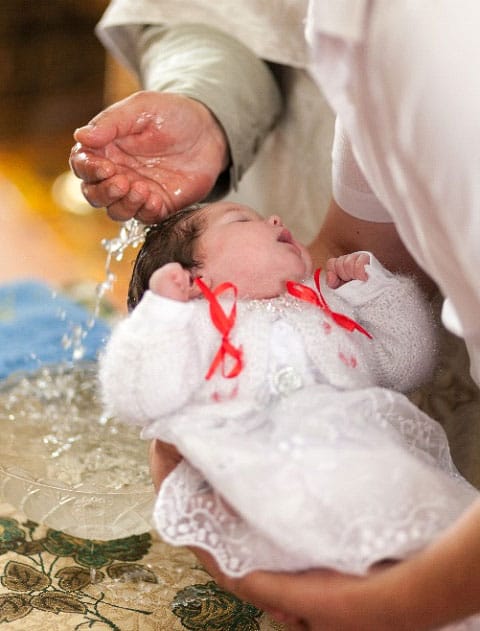Conducting a Baptism
Baptism is a significant religious ceremony that welcomes a new member into a faith community. Many Christian denominations celebrate the rite of baptism; it is commonly found in Orthodox, Catholic, and Protestant sects. Baptism, however, has also been adopted and celebrated by people of religious faiths outside of the Christian tradition. This is a rite that may be conducted early in life or later in life when a conscious decision is made to affiliate with a particular religious tradition. Because baptism frequently marks the formalized affiliation of a person with a tradition, it is often an important part of the conversion process. Undergoing the rite of baptism may be the culmination of a period of dedicated study and reflection.
This guide is designed to provide basic information about performing a baptism. If you think you might require more advanced instruction, or would like to offer those you baptize a special certificate in honor of this very special ceremony, we would invite you to order our popular Universal Life Church Baptism Package, which includes a comprehensive guide to performing baptisms, high-quality, embossed baptismal certificates, and a special "Clergy" badge. You can also download our baptism planning checklist to help you and the family get started.
Though each denomination has its own way of conducting the rite of baptism, at its heart it is the symbolic use of water to cleanse a person of their sin. The water of baptism also prepares the person receiving the rite for a spiritual fresh start as a new member of a congregation or faith tradition. Many denominations regard baptism as a form of spiritual birth that ushers the participant into a new life as an adherent of the tradition. If you are searching for a minister to host a baptism ceremony, Get Ordained™ has a Find a Minister tool that will let you search for a minister that will help you with your baptism proceedings.
Pastors, priests, and ministers are most typically called on to perform this ceremony. Universal Life Church Ministers in particular are frequently called upon to perform baptisms for friends, family, members of their own congregations, or strangers. Baptism may involve the full immersion of a person in water though in some cases, such as the baptism of infants, a handful of water or even a few drops of water might be used. The ULC produced the following video in hopes of better explaining the difference between the two types:
Christian Baptisms

Many Christian denominations conduct baptismal rites according to the Trinitarian formula, which involves the specific mention of the Father, Son, and Holy Spirit. The basis for this formula comes from Matthew 28. However, some Christian denominations prefer to use the formula given by the apostle Peter in the Book of Acts, which urges people to "Repent and be baptized [...] in the name of Jesus Christ" specifically.
If you have been asked to conduct a baptism for someone wishing to become a member of a certain Christian denomination, you can look into what formula is specifically utilized by that tradition. Other clergy members and ministers may also have relevant information about the particular rite you will be conducting.
If you have been asked to conduct a baptism for someone wishing to become a member of a certain Christian denomination, you can look into what formula is specifically utilized by that tradition. Other clergy members and ministers may also have relevant information about the particular rite you will be conducting.
Steps to Performing a Baptism
Baptism is a relatively simple ceremony comprised of at least two people - the person receiving baptism and the person conducting the rite. Though the precise words and actions will vary between traditions, these are the steps that most rites of baptism include.
- The person or infant to be baptized is dressed in a white gown or robe. In Christianity, white symbolizes spiritual purity and the rebirth offered by the rite. When an infant is baptized, the child and parents arrive at the church or baptismal location.
- Prayers and blessings are said. These prayers cleanse the child of original sin; adults are cleansed of original sin and all sins committed up to this point in life.
- The person receiving baptism is supported. Parents and godparents hold infants. Adult and child recipients are supported by the minister or priest. The minister places one arm around the shoulders of the recipient and the other hand gently pinches their nostrils together.
- The person enters the The supported infant has water poured over its head; in some cases the child is immersed fully in the baptismal font. Adult and child recipients lean back to immerse themselves in the baptismal font. The minister keeps an arm behind the recipient's shoulders and helps them right themselves after immersion. Alternatively, the baptism (particularly in the case of adult baptism) may take place in a natural water source, like a lake or river.)
- The baptism is complete. The person receiving baptism is now regarded as a full member of the congregation. Some denominations keep records noting the date and location of baptism; appropriate forms can be obtained through relevant religious bodies.
A baptism may be a private event with just some family members and supportive friends in attendance or it may take place in the company of a congregation. Baptismal rites may take place for an individual or for a group of people if the opportunity to receive baptism will not soon be available again. The immersion takes place individually.
When is the Right Time to be Baptized?

Each Christian denomination practicing baptism has different guidelines and recommendations regarding the time of baptism and what might need done to qualify for this rite. Several denominations, including the Roman Catholic Church, practice infant baptism to cleanse original sin. Denominations that do not believe in original sin, including many Protestant denominations, offer baptism to members who have made the decision to accept Jesus Christ as their savior and to repent of the sins they have committed. Children and young adults might choose to be baptized; some denominations suggest that an adult sponsor recommend a child for baptism. Adolescent and adult converts to a Christian denomination may not require sponsorship, though some churches recommend a period of religious education and reflection before accepting this rite.
Ministers, priests, and clergy members may be asked to counsel someone considering accepting baptism. This is an opportunity to ask about a person's beliefs regarding this rite and how they feel it will contribute to their spiritual development. Though baptism is a cause for celebration in people's lives, it is also a solemn and sacred affair that can mark the beginning of a new chapter in a person's spiritual search. A person seeking baptism should understand what this rite means to the particular tradition they wish to join.
Baptism Outside Christianity
Though rare, some spiritual seekers may desire a baptismal rite that is not specifically Christian. They might feel that the symbolism of the rite is very relevant to their personal spiritual journey and so wish to have an experience similar to a Christian baptism to solemnize the adoption of a new belief system or the joining of a religious body.
If you are asked to help conduct such a rite, consider taking the time to speak with the person seeking baptism. They might have very specific ideas about what the rite will entail and what symbols should be used. This information will help you craft an observance that is spiritually fulfilling as well as appropriate for their particular religious goals. The five step baptismal outline above can be used as a general model.
For many people, baptism is the rite that ushers them into a full participation in the religion of their choice. Observing this rite in a meaningful and personal way will help support this momentous occasion.

